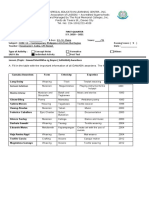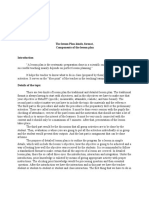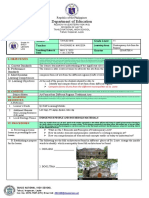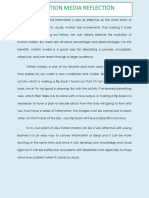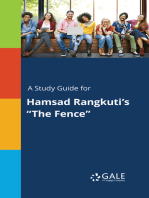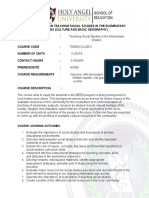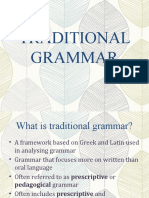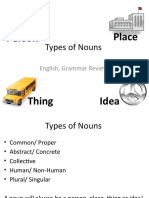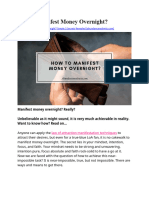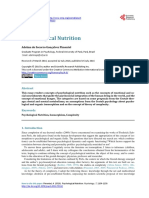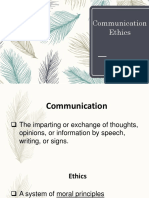The Gawad Manlilikha NG Bayan
The Gawad Manlilikha NG Bayan
Uploaded by
MANILYN GUMBANCopyright:
Available Formats
The Gawad Manlilikha NG Bayan
The Gawad Manlilikha NG Bayan
Uploaded by
MANILYN GUMBANOriginal Title
Copyright
Available Formats
Share this document
Did you find this document useful?
Is this content inappropriate?
Copyright:
Available Formats
The Gawad Manlilikha NG Bayan
The Gawad Manlilikha NG Bayan
Uploaded by
MANILYN GUMBANCopyright:
Available Formats
The Gawad Manlilikha ng Bayan (GAMBA) National Artists (The National Living Treasures)
Background of the Award
In April 1992, the Gawad sa Manlilikha ng Bayan or The National Living Treasures Award was
institutionalized through the Republic Act No. 7355. Tasked with the administration and implementation
of the Award is the National Commission for Culture and Arts (NCCA), the highest policy-making and
coordinating body for culture and the arts of the State. The NCCA, through the Gawad sa Manlilikha ng
Bayan Committee and an Ad Hoc Panel of Experts, conducts the search for the finest artists of the land,
adopts a program that will ensure the transfer of their skill to others and undertakes measures to
promote a genuine appreciation of and instill pride among our people about the genius of the Manlilikha
ng Bayan.
First awarded in 1993 to three outstanding artists in music and poetry, the Gawad sa Manlilikha ng
Bayan has its roots in the 1988 National Folk Artists Award organized by the Rotary Club of Makati-
Ayala. As a group, these folk and traditional artists reflected the diverse heritage and cultural traditions
that transcend their beginnings to become part of our national character. As Filipinos, they bring age-old
customs, crafts and ways of living to the attention and appreciation of Filipino life. They provide us with
a vision of ourselves and of our nation, a vision we might be able to realize someday, once we are given
the opportunity to be true to ourselves as artists have remained truthful to their art.
As envisioned under R.A. 7355, “Manlilikha ng Bayan” shall mean a citizen engaged in any traditional art
uniquely Filipino whose distinctive skills have reached such a high level of technical and artistic
excellence and have been passed on to and widely practiced by the present generation in his/her
community with the same degree of technical and artistic competence.
The National Living Treasures Award, alternative known as the Gawad sa Manlilikha ng Bayan (GUMABA;
lit. Award for the Creators of the Country) is conferred to a person of group of artists recognized by the
Government of the Philippines for their contributions to the country’s intangible cultural heritage. A
recipient of the award, known as a National Living Treasures or Manlilikha ng Bayan is defined as “a
Filipino citizen or group of Filipino citizens engaged in any traditional art and uniquely Filipino, whose
distinctive skills have reach such a high level of technical and artistic excellence and have been passed
on to and widely practiced by the present generations in their community with the same degree of
technical and artistic competence.”
History
The National Living Treasures Award (Gawad sa Manlilikha ng Bayan) was institutionalized in 1992
through Republic Act No. 7355. The National Commission for Culture and Arts, which is the highest
policy-making and coordinating body of the Philippines for culture and the arts, was tasked with the
implementation. This is the line with UNESCO’s criteria of Living National Treasures.
Criteria
To become a National Living Treasure, the candidate must posses the following qualifications:
1. An inhabitant of an indigenous / traditional cultural community anywhere in the Philippines that
has preserved indigenous customs, beliefs, rituals and traditions and/ or has syncretized
whatever external elements that have influenced it.
2. Must have been engaged in a folk- art tradition that has been in existence and documented for
at least 50 years.
3. Must have consistently performed or produced over a significant period, works of superior and
distinctive quality.
4. Must possess a mastery of tools and materials needed by the art and must have an established
reputation in the art as master and make of works of extraordinary technical quality.
5. Must have passed on and/ or will pass on to other members of the community their skills in the
folk art for which the community is traditionally known.
A traditional artist who possesses all the qualities of a Manlilikha ng Bayan candidate, but due to age or
infirmity has left them incapable of teaching further their craft, may still be recognized if;
1. Had created a significant body of works and/or has consistently displayed excellence in the
practice of their art, thus achieving important contributions for its development.
2. Has been instrumental in the revitalization of their community’s artistic tradition.
3. Has passed on to the other members of the community skills in the folk art for which the
community traditionally known.
4. Community has recognized them as master and teacher of their craft.
Categories
The categories are, but not limited to, the following categories of traditional folk arts:
Folk Architecture
Maritime Transport
Weaving
Literature
Graphic and plastic arts
Ornament
Carving
Performing arts
Textile or fiber art
Pottery
Other artistic expressions of traditional culture may be added.
Recipients and Nominees
Recipients
Ginaw Bilog (d.2003), artist and poet, Mansalay. Oriental Mindoro Poetry (Ambahan), 1993
Masino Intaray (d. 2013), musician and epic chanter, Brookes Point, Palawan, Poetry (Kulilal and
Bagit) Music (Basal/Gong), 1993
Samaon Sulaiman (d. 2011), Musician, Mama sa Pano, Maguindanao Music (Kutyapi), 1993
Lang Dulay, (d. 2015) textile weaver, Lake Sebu, South Cotabato, Weaving (Abaca-ikat/ Inabal),
1998
Salinta Monon (d. 2009), Waever, Bansalan, Davao del Sur, Weaving (Abaca -ikat /Inabal), 1998
Alonzo Saclag, musician and dancer, Lubugan, Kalinga Province, Music and Dance (Kalinga), 2000
Frederico Caballero, epic chanter, Sulod-Bukidnon, Iloilo, Poetry / Epic Chant (Sugidanon), 2000
Uwang Ahadas, musician, Lamitan, Basilan, music (Yakan specifically Kulintang, kwitangan kayu,
gabbang agung and tuntungan), 2000
Darhata Sawabi. (d.2005) waever, Parang, Sulu, waeving (Pis Syabit), 2004
Eduardo Mutuc, metalsmith/metal sculptor, Apalit Pampanga, Metalwork (Bronze and Silver),
2004
Haja Amina Appi (d.2013), waever, Tandubas, Tawi-Tawi, Waeving (Mat), 2004
Teofilo Garcia, casque maker, San Quintin, Abra, Casque Making (Tabungaw), 2012
Magdalena Gamayo, master waever, Pinili, Ilocos Norte, Weaving (Inabel), 2012
Ambaang Ausalin, master waever, LAmitan, Basilan, Waeving (Yakantennun), 2016
Estelita Tumandaan Bantilan, master waever, Malapatan, Sarangani, Weaving (B’laan igem),
2016
Yabing Masalaon Dulo, master waever, Polomok, South Cotabato, Weaving (Ikat), 2016
Current Nominees
Whang-od, tattoo artist, Tinglayan, Kalinga, Tattoing (Batek/Batok), nominated October 21, 2017
You might also like
- ACTIVITY 1 - The WorkerDocument37 pagesACTIVITY 1 - The WorkerGHi YHan86% (29)
- UntitledDocument514 pagesUntitledAnya Rowles100% (3)
- Science and Technology and Nation Building: By: Prof. Janet C. TurarayDocument33 pagesScience and Technology and Nation Building: By: Prof. Janet C. TurarayToshi Codm0% (1)
- Welcome Spe-Arts Students!: Ethnic Is Pertaining To or Characteristic of A People, Especially A GroupDocument16 pagesWelcome Spe-Arts Students!: Ethnic Is Pertaining To or Characteristic of A People, Especially A GroupMARMAN ANGA-ANGANNo ratings yet
- Read Lesson 5 Elements and Principles of ArtsDocument29 pagesRead Lesson 5 Elements and Principles of ArtsAlexa Dela CruzNo ratings yet
- LESSON: Brief History of Philippine Art: Artwork by Carlos Botong' FranciscoDocument4 pagesLESSON: Brief History of Philippine Art: Artwork by Carlos Botong' FranciscoKyla BaculiNo ratings yet
- Gawad Sa Manlilikhang BayanDocument21 pagesGawad Sa Manlilikhang BayanCristine FerrerNo ratings yet
- Addressing Climate Change ProblemDocument9 pagesAddressing Climate Change Problemrex rexNo ratings yet
- Rizal's Life: at The End of The Lesson, The Student Should Be Able ToDocument7 pagesRizal's Life: at The End of The Lesson, The Student Should Be Able ToElla Paulette WenceslaoNo ratings yet
- Learning-Module - BALUNO - EditedDocument33 pagesLearning-Module - BALUNO - EditedReynold TanlangitNo ratings yet
- (Template) LAS# 8a Individual WorkDocument1 page(Template) LAS# 8a Individual WorkNik Biado100% (1)
- Contemporary ArtsDocument4 pagesContemporary ArtsShendy AcostaNo ratings yet
- Activity 4 - If I Were An Inventor...Document1 pageActivity 4 - If I Were An Inventor...christian abrenicaNo ratings yet
- National Artist in Visual ArtsDocument40 pagesNational Artist in Visual ArtsBea Rossette0% (1)
- Topic: Week 3 Lesson 1 ObjectivesDocument7 pagesTopic: Week 3 Lesson 1 ObjectivesOmar Adil0% (1)
- Of Philippine Literature in English and Time FramesDocument1 pageOf Philippine Literature in English and Time Framesmanuelgilbert76No ratings yet
- Jojo AssignmentDocument2 pagesJojo Assignmentherbert rebloraNo ratings yet
- Lesson 1 Media and Information LiteracyDocument9 pagesLesson 1 Media and Information LiteracyGabriel PatronNo ratings yet
- Contemporary Philippine Arts From The RegionsDocument12 pagesContemporary Philippine Arts From The RegionsDr 90ioNo ratings yet
- Planting Rice Fernando AmorsoloDocument2 pagesPlanting Rice Fernando AmorsolojasmineNo ratings yet
- The Lesson Plan Kinds Formt Components of The Lesson PlanDocument4 pagesThe Lesson Plan Kinds Formt Components of The Lesson PlanWinnie Joy ApolonioNo ratings yet
- Essence of The Contemporary Arts of The PhilippinesDocument1 pageEssence of The Contemporary Arts of The PhilippinesAra LimNo ratings yet
- Rizal Bilang Mag-Aaral Sa Ibang BansaDocument4 pagesRizal Bilang Mag-Aaral Sa Ibang BansakeuliseutinNo ratings yet
- Art Appreciation Orca - Share - Media1623503611591 - 6809467692113669583Document18 pagesArt Appreciation Orca - Share - Media1623503611591 - 6809467692113669583Lly100% (1)
- Purposive Com. Powerpoint 23Document15 pagesPurposive Com. Powerpoint 23Asnawi DicaliNo ratings yet
- Philippine Folk Dance 1 Update 01Document14 pagesPhilippine Folk Dance 1 Update 01Dhenil ManubatNo ratings yet
- HENDERIN PreSENTATTIONDocument22 pagesHENDERIN PreSENTATTIONHoward Miles CelizNo ratings yet
- National Artist of The PhilippinesDocument23 pagesNational Artist of The PhilippinesYeon Yeon Bae86% (7)
- Contemporary Philippine Arts From The Regions: Quarter 1 - Modules 5Document5 pagesContemporary Philippine Arts From The Regions: Quarter 1 - Modules 5Larry Mart100% (1)
- Physicalscience12 q2 Mod4 Einstein S Theory of Relativity v4Document50 pagesPhysicalscience12 q2 Mod4 Einstein S Theory of Relativity v4UNKNOWN100% (1)
- InterferenceDocument34 pagesInterferenceC M Numan AfzalNo ratings yet
- Seeing The Philippines in Juan Luna'S Spoliarium: Group 1Document6 pagesSeeing The Philippines in Juan Luna'S Spoliarium: Group 1BSIT 1 A File StorageNo ratings yet
- Prof Ed 10 Module 4-Final: Chapter 7: Artistic and Creative LiteracyDocument2 pagesProf Ed 10 Module 4-Final: Chapter 7: Artistic and Creative LiteracyRhina Mae ArguezaNo ratings yet
- Contemporary Arts Form and Practices From The Regions of The PhilippinesDocument3 pagesContemporary Arts Form and Practices From The Regions of The PhilippinesJoyce Orda100% (1)
- Graphic OrganizerDocument2 pagesGraphic OrganizerMYBNG SHPPRNo ratings yet
- CCT Module 1 2Document6 pagesCCT Module 1 2Rth CMglNo ratings yet
- Contextualized Lesson Plan Contemporary ArtsDocument6 pagesContextualized Lesson Plan Contemporary ArtsSerdnelem Rhodz MacedaNo ratings yet
- Lopez, Jose Miguel - Module2 - Activity - Bsa213Document4 pagesLopez, Jose Miguel - Module2 - Activity - Bsa213jsemlpzNo ratings yet
- PAJARON, RASHEL B. (Reaction Paper)Document3 pagesPAJARON, RASHEL B. (Reaction Paper)Rowelyn Pajaron100% (1)
- EthicsDocument3 pagesEthicsmarian calimagNo ratings yet
- Pre-Spanish and Spanish Era - (Angel Acuzar)Document17 pagesPre-Spanish and Spanish Era - (Angel Acuzar)samuel fajiculayNo ratings yet
- RNWDocument19 pagesRNWkydgecruzNo ratings yet
- MODULE Art AppreciationDocument59 pagesMODULE Art AppreciationThrolaj Ben AbrisNo ratings yet
- Workbook ActivityDocument68 pagesWorkbook Activityazmin asriNo ratings yet
- Isa Second Powerpoint 2Document19 pagesIsa Second Powerpoint 2Wenna GeneralNo ratings yet
- Bikolano Literature 21st Century 2nd LessonDocument8 pagesBikolano Literature 21st Century 2nd LessonVeah BiancaNo ratings yet
- Fernando AmorsoloDocument2 pagesFernando AmorsoloGerald Gavina100% (1)
- Kathleen Motionmedia ReflectionDocument1 pageKathleen Motionmedia ReflectionKathleen Valdez BrionesNo ratings yet
- Lesson 1Document11 pagesLesson 1Analyn Bereño ParbaNo ratings yet
- Group 5Document24 pagesGroup 5yen83% (6)
- FT Notes 2 - Task No. 1 - Tenor, The Corporate World and SWOT Analysis (Week 11)Document9 pagesFT Notes 2 - Task No. 1 - Tenor, The Corporate World and SWOT Analysis (Week 11)Johane Grei WallNo ratings yet
- Contemporary Philippine Arts Lesson 9-10Document6 pagesContemporary Philippine Arts Lesson 9-10Joey TaduranNo ratings yet
- GAMABADocument28 pagesGAMABANadia Wan100% (1)
- WORKSHEET No. 2 Contemporary Art FormsDocument3 pagesWORKSHEET No. 2 Contemporary Art Formsmanuel advinculaNo ratings yet
- Educ 6Document4 pagesEduc 6Ailyn CataluñaNo ratings yet
- Region IV-B - ChurchDocument2 pagesRegion IV-B - ChurchRG GarvinNo ratings yet
- The Use of Internet As A Tourism SupportDocument1 pageThe Use of Internet As A Tourism SupportVanessa Garachico0% (1)
- Contermporary Arts Week 4Document3 pagesContermporary Arts Week 4Ira Jane Caballero0% (1)
- Contemporary Philippine Arts From The Regions: Various Contemporary Art FormsDocument5 pagesContemporary Philippine Arts From The Regions: Various Contemporary Art FormsCessá100% (2)
- Traditional Arts and Contemporary ArtsDocument2 pagesTraditional Arts and Contemporary ArtsJhay Son Monzour Decatoria100% (1)
- The Case for Masks: Science-Based Advice for Living During the Coronavirus PandemicFrom EverandThe Case for Masks: Science-Based Advice for Living During the Coronavirus PandemicNo ratings yet
- SSC 2 Reference 1Document35 pagesSSC 2 Reference 1MANILYN GUMBANNo ratings yet
- Course Outline in Teaching Social Studies in The Elementary Grades (Culture and Basic Geography Course TitleDocument3 pagesCourse Outline in Teaching Social Studies in The Elementary Grades (Culture and Basic Geography Course TitleMANILYN GUMBANNo ratings yet
- Assessment Under The K To 12 For TLE TEACHERSDocument87 pagesAssessment Under The K To 12 For TLE TEACHERSMANILYN GUMBANNo ratings yet
- SYLLABUS in GE 2Document8 pagesSYLLABUS in GE 2MANILYN GUMBAN100% (1)
- Reading The Image of The Visual WorkDocument2 pagesReading The Image of The Visual WorkMANILYN GUMBANNo ratings yet
- Traditional GrammarDocument15 pagesTraditional GrammarMaria Alona Sacayanan100% (1)
- Unit 4 JeopardyDocument108 pagesUnit 4 JeopardyBrittany KluemkeNo ratings yet
- Public Administration and AccountabilityDocument3 pagesPublic Administration and AccountabilityShamina PaclipanNo ratings yet
- Growth Mindset at WorkDocument11 pagesGrowth Mindset at WorkBhushan Lohar100% (2)
- AitH Quickstart ENGDocument107 pagesAitH Quickstart ENGildjinnil100% (2)
- Womens Realities Womens Choices pp1-17Document19 pagesWomens Realities Womens Choices pp1-17Lexi100% (1)
- 2021 A Time To Be Silent and A Time To Speak - Intergenerational Family Narrative and Father Loss Before BirthDocument19 pages2021 A Time To Be Silent and A Time To Speak - Intergenerational Family Narrative and Father Loss Before BirthHao YewNo ratings yet
- Using Conditionals: Test ItDocument4 pagesUsing Conditionals: Test ItbarbaraNo ratings yet
- Dennett Vs SearleDocument9 pagesDennett Vs SearleelakhnaNo ratings yet
- 2@$ FPRM, wxcv3 .OuDocument79 pages2@$ FPRM, wxcv3 .OuJon Patrick De CastroNo ratings yet
- Types of NounsDocument14 pagesTypes of NounsPihuNo ratings yet
- A Change of Heart FanficDocument64 pagesA Change of Heart FanficPriscila DuarteNo ratings yet
- Some Properties of Fuzzy Set.: A B B A A B B ADocument9 pagesSome Properties of Fuzzy Set.: A B B A A B B ARajesh kumarNo ratings yet
- Real Analysis-2Document6 pagesReal Analysis-2benulchenuka2No ratings yet
- (David W. Noble) Death of A Nation American CultureDocument400 pages(David W. Noble) Death of A Nation American CultureSyed Sabir MuhammadNo ratings yet
- How To Manifest Money OvernightDocument10 pagesHow To Manifest Money OvernightGaudencio BoniceliNo ratings yet
- Pearce, L. (2019) - Mobility, Memory and The Lifecourse in Twentieth-Century Literature and CultureDocument302 pagesPearce, L. (2019) - Mobility, Memory and The Lifecourse in Twentieth-Century Literature and CultureJoão Alcantara de FreitasNo ratings yet
- Perceptia - Barbara A. Budjac Corvette - Conflict Management - A Practical Guide To Developing Negotiation Strategies-Pearson (2006) - 8Document15 pagesPerceptia - Barbara A. Budjac Corvette - Conflict Management - A Practical Guide To Developing Negotiation Strategies-Pearson (2006) - 8Mădă RădoiNo ratings yet
- Pambayang Kolehiyo NG MaubanDocument17 pagesPambayang Kolehiyo NG MaubanRodmar EscolanoNo ratings yet
- Ahankaar - Mimansha in HindiDocument243 pagesAhankaar - Mimansha in HindiRangothri Sreenivasa SubramanyamNo ratings yet
- Syllabus - Philosophy of Law (Modular)Document4 pagesSyllabus - Philosophy of Law (Modular)Please I Need The File100% (1)
- Final Ansfor Classical Political PhilosophyDocument70 pagesFinal Ansfor Classical Political PhilosophyKevin AntonyNo ratings yet
- Ethics: Only Human Beings Can Be Ethical (De Guzman, Hualda, Puo, Banzon, Bamba, Maty-Eo, Paras, and Tesico, 2018)Document2 pagesEthics: Only Human Beings Can Be Ethical (De Guzman, Hualda, Puo, Banzon, Bamba, Maty-Eo, Paras, and Tesico, 2018)Jazmine BartolomeNo ratings yet
- Preziosi, Donald. Art As History. 1990Document42 pagesPreziosi, Donald. Art As History. 1990jujuNo ratings yet
- Excerpt From "Orthodoxy and The Religion of The Future" - by Fr. Seraphim RoseDocument35 pagesExcerpt From "Orthodoxy and The Religion of The Future" - by Fr. Seraphim RoseTihamér SzuszekNo ratings yet
- Psychological Nutrition: Adelma Do Socorro Gonçalves PimentelDocument6 pagesPsychological Nutrition: Adelma Do Socorro Gonçalves PimentelAisiri RaoNo ratings yet
- Communication EthicsDocument21 pagesCommunication EthicsBry RamosNo ratings yet










